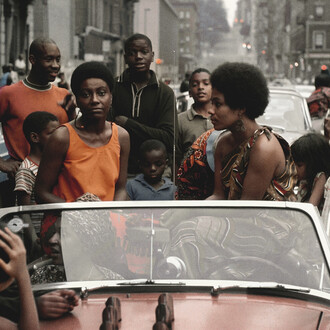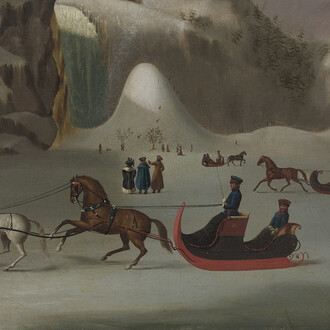BC’s fossil sites include an astonishing diversity of past life spanning the entire interval of complex organisms on Earth. Some of the oldest fossils in the RBCM collection are over 550 million years old. These are the Ediacaran fossils from Mount Robson Provincial Park. Some of the youngest fossils in the collection include clams and other invertebrates from the Victoria area that are only a few thousand years old.
Our fossils represent many different ancient environments—the oceans, lakes and land where plants and animals once lived and died. We have examples from the deep ocean, where unusual marine reptiles, fishes, invertebrates and single-celled organisms once lived; coastlines, where diverse communities of shelled creatures thrived in the ancient past; lake bottoms and shorelines, where plants provided shelter and food for a myriad of fish and insects; and forests and wetlands full of plants, where small and large vertebrates once skittered and roamed.
BC has one of the most complicated geological settings on Earth. Ancient island terranes rising from the ocean floor collided with the North American continent, where they were squeezed upwards to build the mountains of BC. The past life preserved in these rocks is now visible as fossils, which help us understand the deep history of BC and its geologic past. Fossils have played an important role in BC’s economy, helping to locate mineral deposits, oil and gas. Many fossils contain particular chemicals; change in the character of such compounds can reveal the history of the deposit containing the fossils and give us clues to the location and nature of resource deposits. Fossil layers can also assist us in placing rock layers in relation to each other and figuring out their age.
Fossils are primarily found in sedimentary rocks from many basins in the province. Volcanic rocks, such as ash, also may preserve fossils. BC has some of the most important fossil localities in the world such as the Burgess Shale (a UNESCO World Heritage Site containing fossils from the Middle Cambrian period), Mount Robson Provincial Park (containing Ediacaran fauna), Wapiti Lake Provincial Park (fossil fishes and ichthyosaurs), northeastern BC (diverse invertebrates, vertebrates, track ways), Haida Gwaii (diverse mollusks 220–20 million years old), the Nanaimo Group on Vancouver Island and in the Gulf Islands (marine vertebrates and mollusks), the McAbee and other Eocene beds in the BC interior (plants, insects, fishes and other vertebrates) and Cenozoic invertebrates and vertebrates in coastal and southern Vancouver Island.
Over 2000 specimens are part of the museum’s early collections from before 1900. Many of these were collected by Dr. Charles Newcombe, a notable BC naturalist and historian. Other early fossil finds were made by some intriguing figures from BC’s past, among them George Mercer Dawson of the Geological Survey of Canada; Lady Amelia Douglas, the wife of Sir James Douglas who was appointed governor of the Colony of British Columbia in 1858; Captain John Devereux, the dockmaster at Esquimalt harbour 1886–1906; and Captain Gardner, a local sea captain of some renown. Many of the fossils were identified and mentioned in volumes on Mesozoic Fossils (1876-1903) by Joseph Frederick Whiteaves, who joined the paleontology branch of the Geological Survey of Canada at Montreal in 1875. We still regularly refer to these volumes to initiate identification of fossils from Haida Gwaii, Vancouver Island and the Gulf Islands. These older collections are important to show changes in the original sites as they eroded and revealed different fossils over time.
The museum’s paleontology collections have grown from about 2000 specimens in the late 1800s to over 60,000 specimens today. Much growth has occurred over the last ten years, mainly from donations and from research and field collection. Fossils are the museum’s most rapidly growing collection at this time and are frequently the basis for new scientific papers. Today, many of BC’s fossils remain in museums, institutions and private collections outside the province (in Edmonton, Calgary, Drumheller, Ottawa, Toronto, Washington DC and London, England, among other locations). One of our goals is to develop the fossil collections through donations and research to more completely represent the diversity of past life found in BC rocks over its long and complex geological history.
In 2008, a donation of over 20,000 specimens was accepted by the Royal BC Museum. A second large collection arrived in late 2010. The majority of these fossils were collected from Vancouver Island and the Gulf Islands (Nanaimo Group rocks) and they are about 70-80 million years old. This second large collection was declared a National Treasure. The anonymous donor had collected the fossils over 35 years. The largest fossil is about 1 metre across and the smallest less than 1 cm. Examples of the marine fossils include ammonites, bivalves, gastropods, crustaceans (crabs and lobsters) and vertebrate bones (e.g. birds, marine reptiles). The fossils represent offshore marine and near-shore life that existed when the dinosaurs lived on land to the east on the North American continent. The climate was warmer than today, and some of the vegetation included palms and cycads.
Citizens of British Columbia play an important role in donating fossils to BC museum and institutions. Many new species and rare specimens have been collected by the public. To date, most of the fossil collection has been donated by the public. Careful documentation of find site locations, the fossil's association with other fossils and the type of rock it was found in greatly increase the scientific value of a fossil.
Fossil identifications are completed by staff, research associates, visiting researchers and expert volunteers. Important to the collection is research literature and web information. We compile current information and old literature to assist with identifications. Some of the literature is from the nineteenth century, and this needs to be properly conserved but while remaining accessible for future reference. In paleontology, original species descriptions and illustrations are frequently referred to for identifications, and therefore this information needs to be archived. Sometimes the literature has been scanned and can be read on the computer, but this does not match the quality seen in an original publication. To further assist with identifications, we are building keys that organize and prioritize diagnostic characteristics and features of fossils that can be used to differentiate species.
















